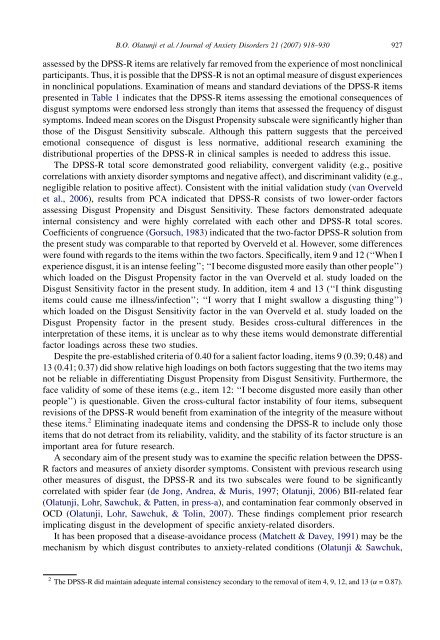The Disgust Propensity and Sensitivity Scale-Revised - University of ...
The Disgust Propensity and Sensitivity Scale-Revised - University of ...
The Disgust Propensity and Sensitivity Scale-Revised - University of ...
- No tags were found...
Create successful ePaper yourself
Turn your PDF publications into a flip-book with our unique Google optimized e-Paper software.
B.O. Olatunji et al. / Journal <strong>of</strong> Anxiety Disorders 21 (2007) 918–930 927assessed by the DPSS-R items are relatively far removed from the experience <strong>of</strong> most nonclinicalparticipants. Thus, it is possible that the DPSS-R is not an optimal measure <strong>of</strong> disgust experiencesin nonclinical populations. Examination <strong>of</strong> means <strong>and</strong> st<strong>and</strong>ard deviations <strong>of</strong> the DPSS-R itemspresented in Table 1 indicates that the DPSS-R items assessing the emotional consequences <strong>of</strong>disgust symptoms were endorsed less strongly than items that assessed the frequency <strong>of</strong> disgustsymptoms. Indeed mean scores on the <strong>Disgust</strong> <strong>Propensity</strong> subscale were significantly higher thanthose <strong>of</strong> the <strong>Disgust</strong> <strong>Sensitivity</strong> subscale. Although this pattern suggests that the perceivedemotional consequence <strong>of</strong> disgust is less normative, additional research examining thedistributional properties <strong>of</strong> the DPSS-R in clinical samples is needed to address this issue.<strong>The</strong> DPSS-R total score demonstrated good reliability, convergent validity (e.g., positivecorrelations with anxiety disorder symptoms <strong>and</strong> negative affect), <strong>and</strong> discriminant validity (e.g.,negligible relation to positive affect). Consistent with the initial validation study (van Overveldet al., 2006), results from PCA indicated that DPSS-R consists <strong>of</strong> two lower-order factorsassessing <strong>Disgust</strong> <strong>Propensity</strong> <strong>and</strong> <strong>Disgust</strong> <strong>Sensitivity</strong>. <strong>The</strong>se factors demonstrated adequateinternal consistency <strong>and</strong> were highly correlated with each other <strong>and</strong> DPSS-R total scores.Coefficients <strong>of</strong> congruence (Gorsuch, 1983) indicated that the two-factor DPSS-R solution fromthe present study was comparable to that reported by Overveld et al. However, some differenceswere found with regards to the items within the two factors. Specifically, item 9 <strong>and</strong> 12 (‘‘When Iexperience disgust, it is an intense feeling’’; ‘‘I become disgusted more easily than other people’’)which loaded on the <strong>Disgust</strong> <strong>Propensity</strong> factor in the van Overveld et al. study loaded on the<strong>Disgust</strong> <strong>Sensitivity</strong> factor in the present study. In addition, item 4 <strong>and</strong> 13 (‘‘I think disgustingitems could cause me illness/infection’’; ‘‘I worry that I might swallow a disgusting thing’’)which loaded on the <strong>Disgust</strong> <strong>Sensitivity</strong> factor in the van Overveld et al. study loaded on the<strong>Disgust</strong> <strong>Propensity</strong> factor in the present study. Besides cross-cultural differences in theinterpretation <strong>of</strong> these items, it is unclear as to why these items would demonstrate differentialfactor loadings across these two studies.Despite the pre-established criteria <strong>of</strong> 0.40 for a salient factor loading, items 9 (0.39; 0.48) <strong>and</strong>13 (0.41; 0.37) did show relative high loadings on both factors suggesting that the two items maynot be reliable in differentiating <strong>Disgust</strong> <strong>Propensity</strong> from <strong>Disgust</strong> <strong>Sensitivity</strong>. Furthermore, theface validity <strong>of</strong> some <strong>of</strong> these items (e.g., item 12: ‘‘I become disgusted more easily than otherpeople’’) is questionable. Given the cross-cultural factor instability <strong>of</strong> four items, subsequentrevisions <strong>of</strong> the DPSS-R would benefit from examination <strong>of</strong> the integrity <strong>of</strong> the measure withoutthese items. 2 Eliminating inadequate items <strong>and</strong> condensing the DPSS-R to include only thoseitems that do not detract from its reliability, validity, <strong>and</strong> the stability <strong>of</strong> its factor structure is animportant area for future research.A secondary aim <strong>of</strong> the present study was to examine the specific relation between the DPSS-R factors <strong>and</strong> measures <strong>of</strong> anxiety disorder symptoms. Consistent with previous research usingother measures <strong>of</strong> disgust, the DPSS-R <strong>and</strong> its two subscales were found to be significantlycorrelated with spider fear (de Jong, Andrea, & Muris, 1997; Olatunji, 2006) BII-related fear(Olatunji, Lohr, Sawchuk, & Patten, in press-a), <strong>and</strong> contamination fear commonly observed inOCD (Olatunji, Lohr, Sawchuk, & Tolin, 2007). <strong>The</strong>se findings complement prior researchimplicating disgust in the development <strong>of</strong> specific anxiety-related disorders.It has been proposed that a disease-avoidance process (Matchett & Davey, 1991) may be themechanism by which disgust contributes to anxiety-related conditions (Olatunji & Sawchuk,2 <strong>The</strong> DPSS-R did maintain adequate internal consistency secondary to the removal <strong>of</strong> item 4, 9, 12, <strong>and</strong> 13 (a = 0.87).




